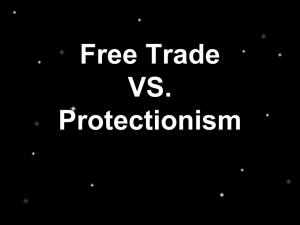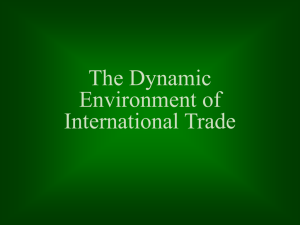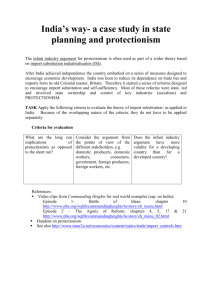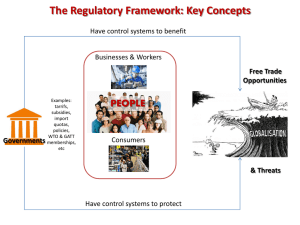International Business in English
advertisement
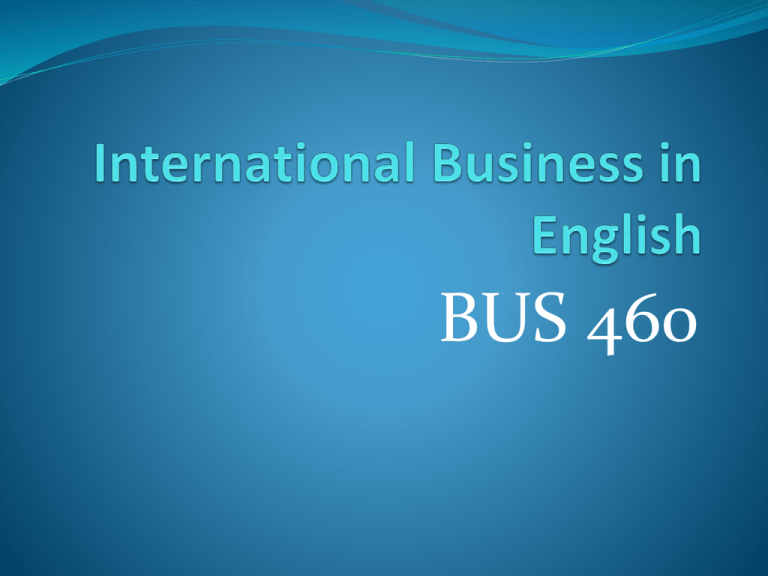
BUS 460 INTERNATIONAL TRADE AND FOREIGN DIRECT INVESTMENT Introduction: International business is concerned with the purchase and sale of goods and services across national boundaries. As such, the volume and direction of business transactions impacts directly upon world statistics for international trade and foreign direct investment (FDI). The pattern of international trade and investment is constantly changing and evolving. One noticeable change has been the growth of regionalism. International Trade: The Theory Mercantilism: Mercantilism: Mercantilists saw trade as a zero sum game – a game such as beggar-my-neighbor. Where one players gains are another’s losses. A mercantilist nation was one that strove to maximize its exports and minimize its imports. International Trade: The Theory Mercantilism: Mercantilism: The margin between the two – what would now be termed as a surplus on the current account of balance of payments – would be matched by the inflows of gold and foreign currency it received for its net exports and added to its reserves. The larger these reserves , the stronger the nation would feel in its dealings with the rest of the world. International Trade: The Practice Trade Barriers and Protectionism Trade Barriers and Protectionism: The most commonly cited reasons for protectionism: 1- The need to protect a country’s infant industries: A third world country seeking to reduce its dependence on primary produce by a nurturing a manufacturing sector may feel a compelling need to protect its manufacturers from foreign competition while they are establishing themselves. But: once provided, it notoriously difficult to withdraw. Trade Barriers and Protectionism 2- To protect domestic industries from unfair foreign competition: One common form of unfair competition is dumping. The practice of selling goods on export markets at less than on home markets. It is understandable if firms facing dumping by their overseas competitors react by calling for tariffs to be imposed to eliminate the prices differential. Trade Barriers and Protectionism 3- Health/social reasons: For health reasons you cannot normally import fresh fruit into the USA or live animal from the UK. Firearms and drugs are also typically subject to strict import controls for reasons which have little or nothing to do with economics. But nonetheless reflect a form of protectionism. Trade Barriers and Protectionism 4- Protection of local culture or national identity: The call for agricultural protection widely heard within western Europe since the establishment of the Common Agricultural Policy. Based on members’ desires to protect local culture. France sees trade barriers as a legitimate means of helping them to preserve their rural traditions. Trade Barriers and Protectionism 5- Politics: Political reasons for not wishing to trade with particular countries include compliance with international sanctions. And a desire not to be reliant to overseas suppliers for strategically important goods such as defense equipment. Equally, countries may wish to grant preferential trading terms to a former colony/political ally. Trade Barriers and Protectionism 6- Protection from cheap foreign labor: The argument has been used by labor unions in the USA, Who are concerned at the replacement of US-based plants with Mexico-based ones, In the aftermath of the formation of NAFTA. Forms of Protectionism: 1- Tariffs: Taxes or duties typically levied on imports as they enter the country. 2- Import quotas: restrictions on the quantity of a good which may be imported, perhaps from specific countries. 3- Embargoes. 4- Export subsidies. 5- Foreign exchange controls. 6- Non-tariff barriers: such as laws and regulations e.g. product specifications or professional qualifications. GATT and the World Trade Organization (WTO): The General Agreement for Tariff and Trade (GATT) was established in 1947, with 23 founder members. Then extended to include 100 countries. GATT’s aim was to promote trade and reduce/eliminate tariffs. GATT three major rounds: 1- The Kennedy Round in the mid-1960s. 2- The Tokyo Round in the mid-1970s. Both 1 & 2 achieved tariff reduction of about 1/3. GATT and the World Trade Organization (WTO): 3- The Uruguay Round in 1993: which concluded seven years of difficult negotiation. Initiated further cuts in import duties and other tariffs world-wide. It created a new framework for international trade under the aegis of the WTO. Also, Uruguay Round saw 125 countries agreed to an average of 1/3 reductions in tariffs (36% in the developed world and 24% in the LDC’s. Key Trading Principles under GATT and WTO 1- Restrictions on the use of quotas. 2- Allowing of retaliation against ‘unfair’ trading practices. 3- A requirement to grant ‘most favored nation’ concessions to all member countries. 4- Members not allowed to treat imported goods less favorably than domestic production (except GATS). International Trade: The statistics Post World War Two The volume and value of world trade has increased dramatically over the half century since the establishment of GATT. For 50 years trade has been rising faster than the value of world output. Thereby, confirming the growing internationalization of business. The decision to export and import is made not by nations but by individual producers and consumers. How Trade Affects Nation’s Economy There are 3 Main Issues: 1- Comparative advantages change over time, and may move for or against any individual nation. 2- Individual business will respond at differing rates to changes in market demand, and so the gains from trade which accrue to particular nations will reflect this speed of response. 3- The value added by trade in goods and services is unequal. Exporting commodities will generate lower returns than the exports of, say, consumer electronics, because the terms of trade are relatively poor. Foreign Direct Investment (FDI) Introduction: International trade and foreign direct investment (FDI) are closely interlinked. The common factor in both instances is the international / transnational corporation (TNC), because exporting / importing or investing overseas are: Simply alternative ways of internationalizing business. Foreign Direct Investment (FDI) Definition: The transnational corporation is defined as: Comprising parent enterprises and their foreign affiliates. A parent enterprise controls assets of another entity on other country usually via ownership of an equity stake. United Nations Commission for Trade And Development (UNCTAD) assumes a minimum equity stake of 10% as the threshold for control. Foreign Direct Investment (FDI) Statistics: Investing in foreign affiliates requires large amounts of capital, and so FDI tends to be concentrated in the hands of the largest companies. UNCTAD estimates that there are around 60,000 TNC’s across the glob, but The 100 largest concerns account for US$ 4 trillions of sales, equivalent to 36% of total world sales by foreign affiliates. Foreign Direct Investment (FDI) Statistics: The total assets of these 100 companies are worth US$4 trillions, they have over 6 million foreign employees. And, only two of the ‘top 100’ are from developing countries. The World’s 20 Largest NonFinancial TNC’s (1997) Table 2.4 (p.42) shows that: 1- The vast majority of corporations in the top 100 TNCs have parent enterprises in the Triad nations. 2- The average size of TNCs from developing countries is only $1.4 billion compared with $13.3 billion for the top 100 TNCs. 3- Four industries dominate the list – electronics and electrical components, petroleum, chemicals and pharmaceuticals, and the automotive business. The World’s 20 Largest NonFinancial TNC’s (1997) Table 2.4 (p.42) shows that: (continued) 4- The corporations ranked most highly in terms of the trans-nationality figures predominantly have parent enterprises in smaller industrialized countries. Such as: Netherlands and Switzerland (Nestle & Unilever). 5- Central European TNCs are still relatively small. 6- A large proportion of FDI flows are devoted to cross-boarder mergers and acquisition. Reasons for FDI: 1- Increased profit. 2- New markets. 3- Protectionism. 4- Extending the product life cycle. Reasons for FDI: 1- Increased profit: Commercial companies are always on the look-out for opportunities to raise profits. Either via cost reductions, higher sales volume or higher prices. 2- New markets: From an operational management prospective, it does not make sense to ship cars over huge distances, so Penetration of foreign markets requires the establishment of regional production facility. Reasons for FDI: 3- Protectionism: Import restrictions may make it difficult for a company to gain a foothold in a foreign marketplace, and The only solution is to produce locally. 4- Extending product life cycle: If a company finds that a product is reaching technological maturity or the ends of its lifecycle in the traditional markets, FDI may provide means of extending the cycle by moving into new markets. Characteristics of the Source Nations: Relatively old figures (1998): The bulk of FDI flows originate from Europe, USA and Japan. FDI outflows from the EU reached a massive US$386 billion in 1998, a rise of over 50% from 1997. The USA FDI outflows for 1998 equaled US$133 billion. Those of Japan fell by 7% to US$24 billion. Across the OECD countries, the value of FDI outflows rose from US$ 321 billion in 1996 to over US$ 566 billion in 1998. Characteristics of Host Nations: Relatively old figures (1998): The inflows of investment to the developed world amounted to 68% of the world total in 1998. The total drawn in by the OECD countries equaled US$ 465 billion in 1998. The EU is the largest recipient of the money. Inflows to the EU rose from US$ 130 billion in 1997 to US$ 230 billion in 1998. The inflows of investment to the USA was very large amounted US$ 193 billion in 1998. Was US$ 111 billion in 1997. The US-EU Banana War مت حبمد هللا THE END
